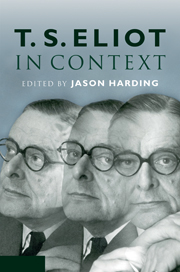Book contents
- Frontmatter
- Contents
- List of illustrations
- List of contributors
- Acknowledgements
- List of abbreviations
- Introduction
- PART ONE LIFE
- PART TWO FORMS
- PART THREE LITERARY CROSS-CURRENTS
- 16 Allusion: the case of Shakespeare
- 17 Classics
- 18 Dante
- 19 Seventeenth-century literature
- 20 Romantic and Victorian poetry
- 21 French poetry
- 22 Georgian poetry
- 23 Bloomsbury
- 24 Ezra Pound
- 25 The avant-garde
- PART FOUR POLITICS, SOCIETY AND CULTURE
- PART FIVE RECEPTION
- Further reading
- Index
23 - Bloomsbury
Published online by Cambridge University Press: 05 August 2012
- Frontmatter
- Contents
- List of illustrations
- List of contributors
- Acknowledgements
- List of abbreviations
- Introduction
- PART ONE LIFE
- PART TWO FORMS
- PART THREE LITERARY CROSS-CURRENTS
- 16 Allusion: the case of Shakespeare
- 17 Classics
- 18 Dante
- 19 Seventeenth-century literature
- 20 Romantic and Victorian poetry
- 21 French poetry
- 22 Georgian poetry
- 23 Bloomsbury
- 24 Ezra Pound
- 25 The avant-garde
- PART FOUR POLITICS, SOCIETY AND CULTURE
- PART FIVE RECEPTION
- Further reading
- Index
Summary
‘Bloomsbury Group’ is convenient shorthand with which to identify the disparate individuals associated with the term, but there is no ‘Bloomsbury’ context for Eliot. Despite the fears of Wyndham Lewis that he was ‘under the poor and ridiculous uterine influence’ of being ‘too fundamentally at house with Bloomsburies’, and despite John Middleton Murry's pronouncement ‘Wherever “The Waste Land” is, it is not situated in Bloomsbury’, Eliot's relations with those whom Leonard and Virginia Woolf termed ‘Old Bloomsbury’ were singular, not collective. In addition to themselves, the Woolfs regarded Clive and Vanessa Bell, Adrian Stephen, E. M. Forster, Roger Fry, Duncan Grant, J. M. Keynes, Desmond and Molly MacCarthy, Saxon Sydney-Turner and Lytton Strachey as members of ‘Old Bloomsbury’. As Quentin Bell remarked, the Bloomsbury Group ‘can hardly be said to have had any common ideas about art, literature or politics’. It had ‘no body of doctrine, no code of conduct, no masters’. Both Leonard and Virginia Woolf held that ‘Bloomsbury’ was a creation of journalists and rivals, a term of abuse. Yet even those who, like the Woolfs, denied the existence of the Bloomsbury Group also acknowledged the central importance in their lives of those friends identified as belonging to it.
For John Maynard Keynes as a student at Cambridge at the turn of the twentieth century, the moral philosopher G. E. Moore's Principia Ethica (1903) was the bible of a new religion. Eliot's own scepticism about philosophical idealism, expressed in his Ph.
- Type
- Chapter
- Information
- T. S. Eliot in Context , pp. 231 - 240Publisher: Cambridge University PressPrint publication year: 2011



